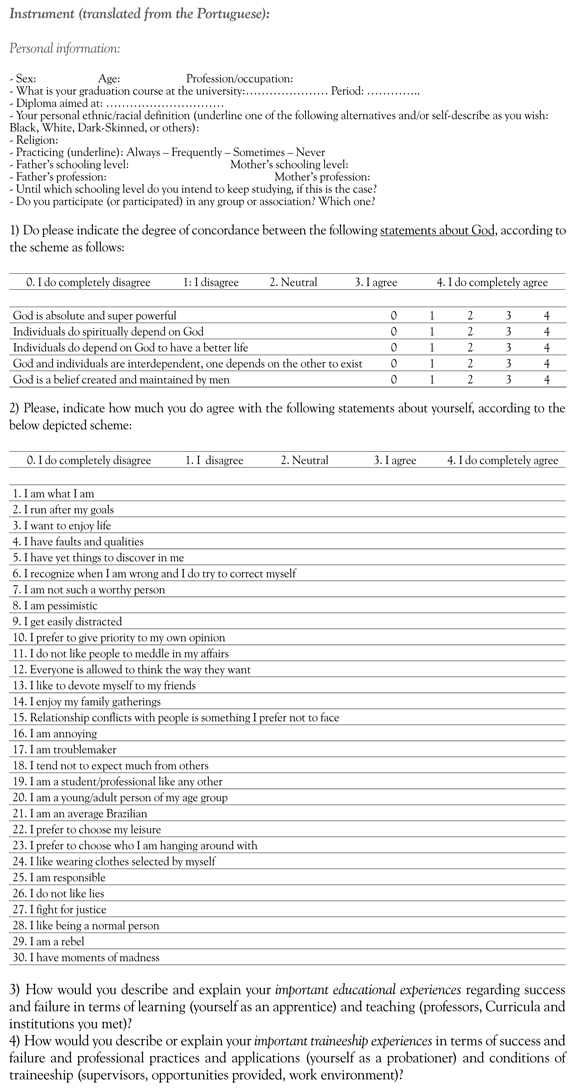Services on Demand
Journal
Article
Indicators
-
 Cited by SciELO
Cited by SciELO -
 Access statistics
Access statistics
Related links
-
 Cited by Google
Cited by Google -
 Similars in
SciELO
Similars in
SciELO -
 Similars in Google
Similars in Google
Share
Universitas Psychologica
Print version ISSN 1657-9267
Univ. Psychol. vol.14 no.2 Bogotá Apr./June 2015
https://doi.org/10.11144/Javeriana.upsy14-2.iadc
God representation, self representation, and educational experience among university students in Rio de Janeiro*
Representaciones de Dios, auto-representación y experiencia educacional entre estudiantes universitarios en Rio de Janeiro
Edson A. de Souza Filho*
Universidade Federal do Rio de Janeiro
*Acknowledgements: I am grateful to Maria Silvia Possas, who has read a first draft of this paper and provided stimulating insight; I am also grateful to Joao Pedro Magalhaes Simoes and Taiza Oliveira Melo, who collaborated as trainees in this research, as well as to the support of CNPq, FAPERJ and PIBIC-UFRJ.
Recibido: 18 de diciembre de 2012 | Revisado: 25 de junio de 2013 | Aceptado: 19 de marzo de 2014
Para citar este artículo
Souza, E. (2015). Representaciones de Dios, auto-representación y experiencia educacional entre estudiantes universitarios en Rio de Janeiro. Universitas Psychologica, 14(2), 695-710. http://dx.doi.org.10.1H44/Javeriana.upsy14-1.gsee
Abstract
This study aimed at verifying relations between God representations (GR), self representations (SR), and learning educational experience (LEE) among graduate students in Rio de Janeiro. We studied GR as beliefs stressing God's power over humans (GR1); spiritual power (GR2); providence of a better human life (GR3); mutual dependence between God and humans (GR4); and disbelief of its existence (GR5). We treated SR as composed by individual-self, interpersonal-self and collective-self. The LEE was studied as events produced mainly because of an action of the student's own learning, or as events caused mainly by teaching action over the student, like institution/professor/curricula. We used closed/open questions to research among Economy (n=82) and Psychology (n=107) students. GR1 and GR2 interfered on SR of the interpersonal-self and collective-self; meanwhile the others GR interfered on SR of the individual-self, interpersonal-self and collective-self. Self assertion, assertive interpersonal relation and negative interpersonal relation correlated negatively with LEE.
Keywords: religion belief/practice; self representation; university student; psycho-cultural approach.
Resumen
En este estudio procuramos verificar relaciones entre representaciones de Dios (RD), auto-representaciones (AR), y experiencia educacional (LEE) entre estudiantes universitarios en Rio de Janeiro. Estudiamos representaciones de Dios enfatizando el poder de Dios sobre los humanos (RD1); poderes espirituales (RD2); proveer una mejor vida humana (RD3); dependencia mutua entre Dios y humanos (RD4); y no creencia en su existencia (RD5). Tratamos AR como siendo compuesta por yo-individual, yo-interpersonal y yo-colectivo. La LEE fue estudiada como eventos producidos sobretodo por una acción de aprendizaje del estudiante el/ella misma o como eventos causados por la acción de la enseñanza sobre el estudiante, como institución/ profesor/curriculum. Usamos cuestiones cerradas/abiertas para investigar estudiantes de economía (n = 82) e psicología (n=107). RD1 y RD2 interfirió sobre las AR de yo-interpersonal y yo-colectivo; mientras las otras RD interfirieron sobre las AR del yo-individual, yo-interpersonal y yo-colectivo. Auto-afirmación, auto-afirmación interpersonal y relación interpersonal negativa correlacionaron con LEE.
Palabras clave: creencia/practica religiosa; auto-representación; estudiante universitario; abordaje psicocultural
Introduction
In many countries the number of university students has increased. Their first challenge is to appropriate knowledge outside the common sense and sometimes even to reconstruct or to abandon their previous shared knowledge like religion among other tendencies. It is usual to take it from granted without considering the effects on educational experience. Thus the educational experience at university becomes a more unilateral than multilateral event, in the sense that students as learners tend to put aside their previous own thoughts/ practices, among other unfolding events. To take an example, the individual practice of studying can become something painful for someone more used to collective studying habits. Further, beliefs originated from religion, acting as guides for action may implicate in educational attitudes focusing more or less on learning or/and teaching action. In a country where some religious beliefs are quite widespread the importance of sociocultural rupture with family, for instance, may have an effect over students, even when they are working by themselves to make to a certain extent a cultural mutation. In this sense, the inclusion in a network could have an impact as support or as source of references to be evaluated and adopted regarding eventual confrontation between academic information and common sense.
Religion is a very rich subjective and practical experience, in terms of oneself and with others, including sacred entities. Most of religions in Brazil have a central entity called God, which could be considered a common denominator between them, as many others. In fact, it is very difficulty to find research in Brazil to evaluate the impact of religious beliefs on education. Anyway, in the last years has increased the amount of people without religion reaching around 7,4% in the 2000 National Census (Jacob et al., 2003), but what has been more current in the history of this country is people's shifting among religions, eventually creating new ones (Pereira de Queiros, 1968). But because Catholicism had been the official religion for many centuries, we would say that this influence is the strongest one. So even among Evangelicals who today are over 25% of the religious people, we can find Catholicism's influence in family relations (authors). But in general Evangelicals use to stress religious practices, attending to church or using more frequently religious discourse (authors).
So after extensive qualitative research about GR (authors), we decided to create "scenarios", or statements involving God, religious practices, believers and theirs lives and non believers, which could be considered artificial at a first glance. Yet it can be useful not for the study of religious psychology in itself (Paiva, 2000; Lindeman; Pyysiainen, & Saariluoma, 2002), but to understand its impact over educational experiences. So we formulated four types of beliefs about God as follows: 1) God is an absolute, super-powerful entity; 2) God benefits individuals spiritually; 3) God benefits individuals providing the chance to have a better life; 4) God and individuals are interdependent to exists; but we added a last statement which states the non existence of God in itself, 5) God is a belief created and maintained by men.
Some authors have described the phenomenon of self-presentation (Baumeister, 1998; 1999; Jones et al, 1981; Leary, Tchividjian & Kraxberger, 1994; Owens, 2003; Sedikides & Gregg, 2003; Stryker, 1980), as Goffman (1959) in his book on "the presentation of self in everyday life". For him it could be considered a self image construction in order to comply with social expectancies and to conform to social norms. In this sense, Beauvois, J-L. & Dubois (1988) were able to show how 'internalitywas rather a social norm adopted by students to please teachers, confirming Goffman's theoretical proposal. Many authors reproduced this stress on social conformity to study social interaction until the sixties when innovative social movements emerged everywhere on earth. In fact this trend started at the beginning of the twentieth century in many fields of human activities, perhaps overshadowed by the long period of the so called Cold War. Since then it had been necessary to study interaction also as a search for autonomy, differentiation and delimitation of frontiers among individuals and groups. In this direction is the work (Moscovici, 1976; Moscovici & Doise, 1992) on minority influence in which the importance of social conflict creation to change society was underscored. Or the work of Wicklund & Gollwitzer (1982) who described people as trying to preserve social identity to assert political and religious ideas before an audience that does not share them. It would happen in public situations like at university or other social environments throughout the action of regular individuals and groups without power or external signs of previous social recognition. To face such a challenger of modern times in Westerns societies, diffusion of beliefs about the individualscapacity to change their destiny took place. Therefore, some authors (Farr, 1992) have postulated the existence of a collective norm ('hegemonic representation', Moscovici, 1988) about individualism, what for many countries is followed more in terms of self-image construction like the possession of a diploma, cultural consumption, and so on (Bourdieu, 1984), or even showing external image through the use of material objects like cellular phone or prestigious label cloth (Almeida & Tracy, 2003). Apparently, the legitimacy of the individual as an autonomous, differentiated and delimitated entity would be restricted to some dimensions of the self mainly for the middle classes, meanwhile others groups would be able to appear socially according to collective traits, frequently negatively regarded in society. In another direction, Gergen (1992) described the phenomenon of the 'saturated selfwhen the self representation looses consistency and durability in contemporary life, taking for granted that individual and social self were both lived as something unified and durable before. For us what is more frequent nowadays is the importance of a self-reflexion phenomenon which allows people to become aware about social conventions and, in consequence, bringing them to choose and to reconstruct it. So most of traditional social identifications like belonging to an old religion or ethnic group give place to a more dynamic and free relations with it.
In order to go deeper about self representations (SR), an extensive qualitative research was undertaken previously (authors). The theoretical descriptive proposal adopted here for SR is a three dimensional construct axed on the individual-self, the interpersonal-self and the collective-self.
The individual self would be composed by contents like self assertion, when individuals presented themselves drawing upon personality traits considered something positive or/and neutral ('calm'; 'someone with many objectives and able to accomplish them'; 'beautiful'; 'I am what I am'), for which someone does not need another individual to actualize them; self criticism, from positive and negative personality traits at the same time, as taking stock of himself/herself ('with faults and qualities'); self depreciation, when trying to underscore the negative traits of himself/herself ('anxious'; 'ugly'; 'complicated');
The interpersonal self would be composed, in turn, by assertive interpersonal relation, when introducing himself/herself in situations to assert his/her criteria/positions regarding those from the other people ('I am not concerned about other people say.'; 'I have my own point of view and I do not admit to be contradicted.'I like to make everything by myself.'); positive interpersonal relation, when described himself/herself living a common situation with other people without conflict or feeling something negative, ('someone who is devoted to my family'; 'a playful fellow'); negative interpersonal relation, when described himself/herself living a situation of interaction in which he/she tries in a certain way to boycott/undo it without the explicit purpose of selfpromotion or to assert something belonging to himself/herself or someone else ('bad humoured.'; 'annoying').
Finally, the collective self would be composed by social categorization, when described himself/ herself using demographic categories, in general those employed by official state agencies ('I am a woman'; I am an adolescent of the secondary school.'); group identity, describing himself/herself as been part of a particular group or special traits, in general chosen for a rational purpose ('blond, blue eyes'; 'I am a daughter of Jesus.'); moral value, when describing himself/herself to follow/respect moral general principles ('I hate injustice'; 'I am truthful person'; 'humble.'); social deviance, when introduced himself/herself throughout transgressions/ruptures of general social norms ('I am crazy.'; 'I am not normal.').
Thus, self representation and representation of God seem to be social constructs which offer us analytical tools to understand certain complex processes of learning and teaching and, further, could allow us to evaluate the way students interact with educational environments. For us, what it is at stake is the possibility of emergence of free thinking and action at university, for so it is necessary from an early stage to start acting in an assertive way with oneself and with others. Further, we think that educational autonomy is associated to a starting point of self reflexion, including self criticism, which is possible to happen first of all when its is considered legitimate to think about ourselves as individuals, when the social dimension 'in generalis considered hierarchically as coming after, including the interpersonal interactions. After the consolidation of the individual self (or not), it would start the moment to work the other components of the self in order to rethink and reconstruct social life. Nevertheless, we consider that all the mentioned three parts of the self are experienced together. For doing so, it would be necessary some socio-cultural reflexions and perhaps ruptures or deep transformations (Touraine & Khosrokhavar, 2004). Most of our individual being is received almost passively and ready made from the previous generations without criticism, so we have considered for example lack of belief in god, because it is known to be a break of a social norm in Brazil. After a very comprehensive study of arguments in history, the social psychologist Michael Billig and collaborators (1987; 1988) proposed that each society in any moment maintained specific ideological dilemmas, like the following pairs: authority versus subordinate, dominant and dominated, and so on. For a long period some societies have organized themselves around the dilemma individual versus society. But of course modern society got at the same time multiple axis of ideological debate. In Brazil, as many other countries, religious has become an important system of beliefs which deserves to be more studied together with self representations and educational experience.
So the main objective of this study was to analyse social constructions on God representations in order to verify the impact on self representations, relevant educational experiences and traineeship experiences.
Method
Participants
They were undergraduate students of Economy (n=82) and Psychology (n=107) at the Federal University of Rio de Janeiro. They were 116 females and 69 males and 4 did not declared sex (distributed among the courses as follows: Economy: female=39.1%; male=60.8%; Psychology: female=67.2%; male=32.7%). The average age of the group was 21.82 years old (SD= 2.05146). When answering their religion 31.8% declared to be Catholic, 27.2% without religion, atheist and agnostic; 21.2% did not answer; 8.8% Evangelical, Baptist, Protestant and Christian; 7.4% Spiritualist; 3.9% other religions (Jewish, Hindu, Buddhist, Wicca, Universalist, Santo Daime). About ethnic self-definition, 71.9% declared to be White, 16.4% Mixed, 6.3% Black, 5.2% did not informed. Instrument and procedure
A questionnaire has been specially prepared which is composed by open and close questions (attached) about God, self, relevant educational experiences and relevant traineeship experience. About the instrument concerning God representations, it was considered from two main axes or gradients. The first would situate God as a distant and superpower entity, which would implicate turning in comparison human beings more fragile and passive. The second would situate God in terms of spiritual benefits following religious practices, as well as existing human life, in opposition to the possibility of non religious practices or to doubt about beliefs in God. Regarding Self representations, shall we point out that according to other recent researches on self-descriptions of body; White people in Brazil are very concerned about 'normality(authors). So when we created the questionnaire to study self representations, we had considered this a social deviance/normality concern, mainly because our qualitative researches showed that most regularly what people consider a deviance is a behaviour at the opposite pole of normality, like not following the general rules of rationality or common sense (for instance, to be mad, to be drug addict, and so on) not accomplishing what we might call a singularity. Additionally, they filled socio-demographic questions (Age=A), regarding parentsschooling (PS), religion practice intensity (RP), level of educational aspiration (graduate, master, PhD, Pos-doc) (LA), among others. They were asked to fill the questionnaire once they had signed a freely consented agreement. The application took place during break times between classes.
Analysis of data
The God representation instrument was tested for reliance and we found Cronbach-Alpha of 0.77. And the Self representation instrument also was tested for reliance and we found Cronbach-Alpha of 0.715. ANOVA's tests were run, followed by Pearson's correlations and kruskal-wallis's and Mann-Whitney's mean tests among demographics variables using SPSS. The relevant educational experiences were considered according to their level of focus on the student him/herself as a learner, using content analysis (Bardin, 1991). So level 1, they treated it mainly (at least 60% of the assertions) as teaching (professor/curricula/institution); level 2, they treated, simultaneously as learning and teaching experiences; and, level 3, mainly as learning experiences (at least 60% of the assertions), it generated a gradient of Learning Educational Experience (LEE), as well as that of Learning Trainee Experience (LTE).
About the parentsschooling, it was considered the higher level reached by both parents, which ranged from primary school to post-graduation. Finally, for the demographic analysis we run non parametric tests to compare means among groups.
Results
Before to present the main results, it is important to mention the following correlations between the statements about God:
- GR1 correlated positively with GR2 (R=0.633; p<0.000; n=188).
- GR1 correlated positively with GR3 (R=0.573; p<0.000; n=187).
- GR1 correlated positively with GR4 (R=0.230; p<0.001; n=188).
- GR1 correlated negatively with GR5 (R=-0.634; p<0.000; n= 188).
Below the main ANOVA testsresults concerning the God representations and Self representations:
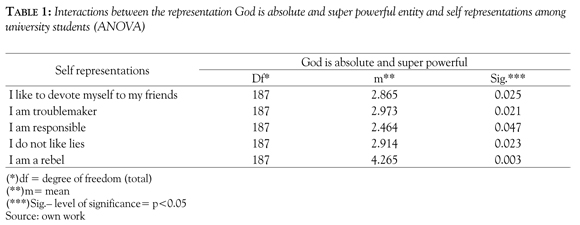
Summarizing the main results of God representations as independent variables on Self representations above presented, the GR1 and GR2 tended to interfere on the SR related to interpersonal relations (positive and negative), as well as collective-self (moral value and social deviance). Meanwhile, GR3, GR4 and GR5 interfered on the self-individual (self-criticism), and self-interpersonal relation (affirmative and negatives ones), and on collective-self (moral value and social deviance).
About correlations between God representation and LEE and other variables these were as follows:
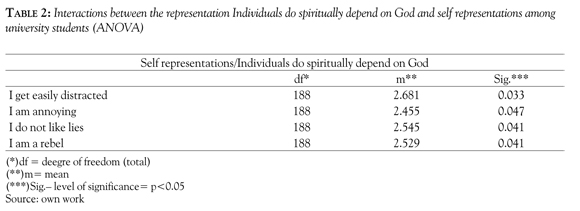

Further, the GR1, GR2 and GR3 correlated negatively to LEE and to parent's schooling, meanwhile GR3 correlated positively to university period and religious practice; and GR5 correlated positively to LEE and parent's schooling.
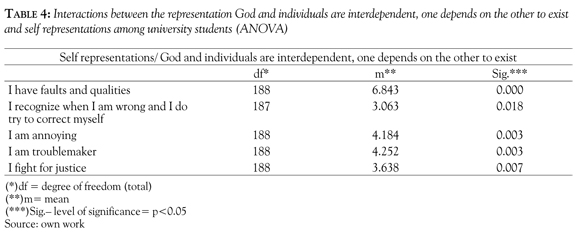
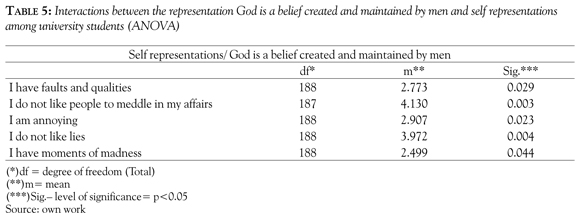
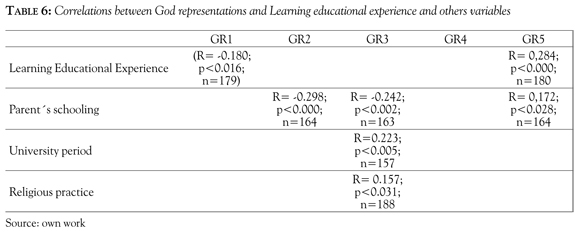

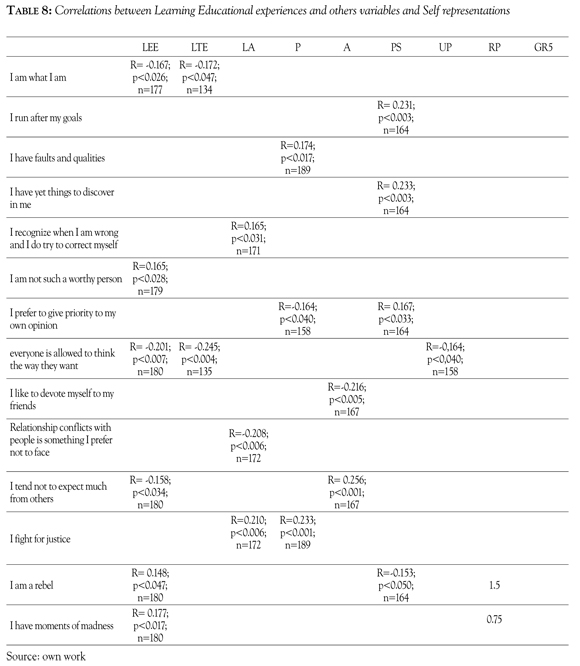
According to the above exposed data, self assertion and assertive interpersonal relation correlated negatively to LEE and LTE, but LEE correlated negatively also to negative interpersonal relation, and positively to self depreciation and social deviance. While self criticism and moral value correlated positively to level of educational aspiration, which correlated negatively to positive interpersonal relation. Self criticism, and moral value correlated positively to university period, which correlated negatively to assertive interpersonal relation; while positive interpersonal relation correlated negatively to aging; and negative interpersonal relation correlated positively to aging. Finally, self assertion, self criticism and assertive interpersonal relation correlated positively to parentsschooling, which also correlated negatively to social deviance.
The most important demographic variables about God representations were religion followed by gender. About religion in general all monotheists tended to show higher GR1 (Catholics=107.68; Evangelicals et al.=118.61; Espiritual-ists=115.06; Others=57.52; Not informed=82.81; p<0.000); GR2 (Catholics=103.59; Evangelicals et al.=125.95; Espiritualists=112.56; Oth-ers=62.93; Not informed=78.69; p<0.000); GR3 (Catholics=112.32; Evangelicals et al.=118.63; Espiritualists=81.88; Others = 66.76; Not in-formed=61.33; p<0.000), but Evangelicals, Protestants, Baptists and Christians pointed less in GR type 4 (Catholics=111.79; Evangelicals et al.=60.89; Espiritualists=83.59; Others=77.14; Not informed=95.08; p<0.000), while those who did not informed religion pointed high also on type 4. Finally, those who declared not having religion pointed higher about GR5, followed by those who did not inform religion (Catholics=80.83; Evangelicals et al.=59.26; Espiritualists=56.47; Others = 119.05; Not in-formed=102.22; p<0.000).
On gender results, females pointed higher about GR1 (X: f=105.02/m=71.64; p<0.000), GR2 (X: f=101.49/m=78.72; p<004), GR3 (X: f=103.55/m=73.65; p<0.000), GR4 (X: f=98.96/m=82.98; p<0.043), and males did about GR5 (X: f=82.57/m=110.54; p<0.000).
In terms of intensity of religious practices we did not find statistically meaningful differences among the religious groups, but among ethnic groups we did. So Whites and Mixed did show more intensity, but those who did not inform their ethnic group had the least means (X: Black=84.83; White=97.16; Mixed=105.06; Not informed=46.60; p<0.019).
It is necessary to mention that LEE correlated high positively with LTE (R= 0.582; p<0.000; n=134).
Among the demographic variables, gender showed more differentiation on self representations. The girls highlighted Self criticism (I have yet things to discover in me) (X: f=101.46/ m=78.78; p<0.000); positive interpersonal relations (I enjoy my family gatherings) (X; f=98.65/ m=83.51; p<0.39); (Relationship conflicts with people is something I prefer not to face) (X: f=100.35/m=80.64; p<0.012); group identity (I like wearing clothes selected by myself) (X: f=101.94/m=78.18; p<0.001); moral value (I am responsible) (X: f=101.94/m=77.96; p<0.006); (I do not like lies) (X: f=98.54/m=83.68; p<0.041); social deviance (I like to be a normal person) (X: f=99.63/m=81.85; p<0.023). Meanwhile, boys stressed negative interpersonal relations (I am annoying) (X: f=85.07/m=106.33; p<0.006); (I am a troublemaker) (X: f=85.92/m=109.95; p<0.001); (I tend not to expect much from others) (X: f=85.18/m=106.14; p<0.006); social deviance (I am a rebel) (X: f=85.37/m=105.83; p<0.008).
Students of economy (E) and psychology (P) have shown the following differences: The level of parents schooling was higher among economy students (X: P=75.15/E=95.23; p<0.001), as well as self assertion (I run after my goals) (X: P=88.86/ E=103.01; p<0.045) and positive interpersonal relation (Relationship conflicts with people is something I prefer not to face) (X: P=85.68/E=107.16; p<0.006), but psychology students stressed self criticism (I have yet things to discover in me) (X: P=102.76/E=84.87; p<0.005).
Discussion
According to the above summarized results, it is possible to state God representations as much as Self representations offer some regularities and tendencies for some questions regarding studentsinvolvement and practice as learners. Before to start our discussion let us remind that among the results that God representations types 1 and 2, in which it was not mentioned the individual in the operationalizations of them in the instrument, there practically was not found any effect over the Self representations in terms of individual-self, except type 2, linked to self depreciation. But among most of the Self representations can be noticed the following dilemmas: whether to follow the moral values or to deviate from them?; whether to keep positive interpersonal interactions or negative ones? In contrast, the individual-self was clearly linked to God representation type 4 and 5, which mentioned the individual. But the dilemmas about keeping interpersonal relations positive or negative, as well as whether to follow the social convention or not were also present, even if it has been in a lesser degree. So we could state that the main ideological dilemmas we found were about outside the individual realm, whether interpersonal or collective (or macro-social) one.
In Brazil, Catholic Christians, which are the majority of Brazilians, do not have such widespread beliefs about the role the individual plays as the main accountable for his/her destiny as Protestants reformers indeed did (Buarque de Holanda, 1936/1984; Farr, 1992). The former usually delegate to a super-powerful entity like God the responsibility for their lives and experiences — what decreased with family educational accumulation of experience, as we have shown in this research.
Regarding God representations and self representations, it became more evident after our research that they are both interlinked constructs. So God representations which put stress on absolute and superpower entity correlated negatively to learning experience, which could implicate to think that the above mentioned student's inhibition are not only situational but something learned before university, which could have its effect reduced through parentsschooling. Another point is the tendency of people when approaching the end of university studies to increase the belief in God as an entity which benefits individuals providing them the chance to have a better life, which came together with positive interpersonal relation (I prefer not to face conflict), and again was attenuated mainly by the presence of parentsschooling. One of the challenges students are facing is the more and more competitive job market, which could implicate in value conflicts for them. For successfully facing it, it would be necessary to become a more active student, both existentially and professionally. In this sense, God belief is part of the challenge, because at least in our Brazilian samples university students as learners, is something associated with non believers. But it is likely that sharing beliefs in God within religious networks could be a practical strategy to face their challenges also, whether internally or externally.
It is necessary to notice that part of the reconstructions of God representations among students approaching the end of university studies is to picture God as a benefactor for their present life which is linked to the belief in the super power of God. Those students who did not inform their religion pointed higher on God type 4, which gives some importance to individuals, which was less important even among Evangelicals, Protestants, Baptists and Christians. So in a certain way it gives support to our assumption that the crucial point for many Christians, Catholics or not is to avoid giving importance to individual action. In addiction, we could say that this reinforcement on social norms was noticed among those who informed their ethnic identification in comparison with those who did not, the last did not practice religion intensively as the former ones. So to reinforce cultural identification (religious and ethnic dimensions) could offer certain self-confidence for people who lacked it in this important moment of their lives.
About the gender differences on God representations, it is necessary to say that religion is something practiced together and it points out the need of social support among youngsters, perhaps more expressed by girls than boys because the former are less concerned to show social dependence. However, the latter group showed stronger tendency to reflect about God belief and even to take distance from it. So it goes beyond. Nevertheless, it is possible that it would be part of a strategy of self image construction, but anyway it was part of existential transformations they are accomplishing during the university studies.
In this sense, the Self representations correlated with learning educational experiences. The main body of results showed an inversed effect in the sense that more self depreciation is followed by more descriptions of educational experiences as a learner. Further, more self assertion will go together with less learning educational experiences.
We may interpret these results primarily as an effect of a lack of an assertive individual norm. So students as learners, when mentioning relevant educational experiences, have shown focus on professors/curricula/institution in itself or together with themselves as learners. At the same time, they avoid to show focus on the individual as learner when they are succeeding since this is not popular. Also, we could interpret these results as a difficulty for students to use self critical representations, preferring more extreme answers to describe their individual self. The same pattern of response was observed in terms of interpersonal relations. So affirmative interpersonal relation, as well as negative interpersonal relation, correlated both negatively to learning educational experiences. Apparently, a learner who is considered as individual tries to be cautious and less assertive towards educational activities. If in our sample we found less assertive people, at the same time we found also others who were not avoiding social conflicts and they have a higher level of educational aspirations. But it is important to remember that the latter have shown more self criticism. So this study confirmed the idea that for an educational change whether at a private or a public level, it is necessary to face conflict. So to understand further the educational itinerary of students, it is important to notice that both university career period and aging correlated negatively to assertive interpersonal relation. This could be interpreted as a gradual search for social relations without conflicts during the university experience. It could be considered whether a developmental/existential fact or something specific to the university experience. In this sense, still regarding learning experience some of the participants showed positive correlation with social deviance. We could posit that the search of social deviation among students who focus on learning activities is the result of stress experienced during academic activities. But this phenomenon was attenuated according to the level of parentsschooling, which has been correlated positively.
It is important to mention that the results data correlating self representation and gender have highlighted some differences between men and women which for us clarify some aspects of the situation students were living. In fact both groups are less prone to start and to keep an assertive relation with themselves and others. So girls have stressed positive interpersonal relation, whereas boys negative interpersonal relation. They complement each other in a certain way in their role-playing situation. Some recent studies in Rio de Janeiro have shown the tendency among girls to think that freedom does not exists and that it is conditioned; and among boys to reclaim freedom, as if it would be something to get fighting about (authors). So the main difference is that one group is still suffering the psychosocial difficulty to face conflict and the other is somewhat 'in the attack(Lorenzi-Cioldi, 1988), without expressing their proposals.
In recent years the pressure over youngsters to accomplish and to succeed increased. Such a phenomenon is followed by higher social control over them. As a consequence, stress and social deviance are stepping up, together with certain difficulty to focus on their academic tasks to the benefit of other activities. For instance, recent research on the use of internet in Brazil has pointed out that youngsters prefer to access social networks instead of those with academic purposes (Duarte & Gunther, 2011). In part, internet would be offering an alternative way to improve quality of interactions for youngsters. At the same time, regarding academic life, it could be considered as evasion to avoid conflict with scholars and/or their socio-cultural background such as religion experience. Other studies in the future could provide opportunity to know if there is any influence of self representations and religious beliefs on the free choice of doctrines and practices to face problems linked to their academic formation as we intend to do. The reported results did not intend to study if professors from the academic institutions in focus were authoritarian or flexible during their interactions with students. It is possible that they did not use to take into consideration the existing common sense of students, including religion, as something that may have an effect on educational practices. To face the situation students had a few alternatives: 1) to put aside their previous knowledge, sometimes forgetting that it remains somewhere in their minds and can re-emerge any time; 2) to reconstruct and change their beliefs, incorporating the academic ideas, in a sort of composition which reformulate theories and practices; 3) to refuse the academic new knowledge, eventually trying to find support for old ideas or new ones found inside or outside themselves; 4) to evade from the academic situation, not taking advantage of it as a forum of learning the existing knowledge nor as a place to develop new ones, among other possibilities.
Thus we consider possible to compare some student situations of interaction at universities as similar to social minorities because they do not have an automatic social recognition when they start their academic life. In this sense, some researches on social influence of minorities (Moscovici & Perez, 2007), showed that there is a tendency among some of them to portray themselves as living unfortunate lives, which had a higher immediate effect of social influence than assertive minorities did, rather reinforcing old beliefs like to offer help in order to feel less guilty without changing any social rule. On the other hand, professors tended to prefer less affirmative students, who confirm their message more than criticise it (authors). So it would be more convenient or strategic for students to comply with teachers. Anyway, there is an almost consensual position among teachers that a student should first of all incorporate all the existing and considered valid knowledge mastered by the former. Considering that the academic university environment reproduces some of the social influence models in terms of power relation, we could raise the hypothesis that students will tend to focus more on the negative results of their learning performance when describing their educational experience than on the positive ones. This is because they would prefer autonomy of students only if it does not disturb the maintenance of the main social academic norms. The same way, those students focusing on teaching would intend to show openness toward the professor and stressing his/her positive evaluation of the curricula and teaching practise in the institution, perhaps trying to stimulate them. The exception would be students coming from families with historic of academic achievements or inserted in social networks, their stress on learning action could be considered a self promotion, not a popular way to show oneself, when people expect humility values, etc. Part of the above presented thoughts is related to the self construction, in its many dimensions.
Thus educational activities should provide more chances to tackle academic tasks linked to a free work and, even, for leisure opportunities in order to keep attention and steady involvement of students. This exploring study has been a first step towards other researches.
References
Almeida, M. I. M., & Tracy, K. de A. (2003) Noites nomades. Espago e subjetividade nas culturas. Rio de Janeiro: Rocco. [ Links ]
Bardin, L. (1991) Analyse de Contenu. Paris: P.U.F. [ Links ]
Baumeister, R. F. (1998). The self. In D. T. Gilbert, S. T. Fiske & G. Lindzey. The handbook of social psychology. (pp.) New York, Oxford: The MacGraw-Hill Companies, Inc. [ Links ]
Baumeister, R. F. (1999). Self-presentation. In R.F. Baumeister (Ed.) The self in social psychology. (pp.) . Philadelphia: Psychology Press. [ Links ]
Beauvois, J. L. & Dubois, N. (1988). The norm of inter-nality in the explanation of psychological events. European Journal of Social Psychology, 18(4), 299316. [ Links ]
Billig, M. (1987) Arguing and thinking - a rhetorical approach to social psychology. Cambridge: C. U. P. [ Links ]
Billig, M., Condor, S., Edwards, D., Gane, M., Mid-dleton, D. J., & Radley, A. R. (1988). Ideological dilemmas: a social psychology of everyday thinking. Londres: Sage. [ Links ]
Bourdieu, P. (1984) Distinction: a social critique of the judgment of taste. Cambridge: C.U.P. [ Links ]
Buarque de Holanda, S. (1936/1984) Raizes do Brasil. Rio de Janeiro: José Olympio. [ Links ]
Duarte, F., & Gunther, I. (2011). Investigando a relaçâo adolescente'internet na perspectiva da psicologia ambiental. Congresso de Psicologia Norte e Nordeste. Salvador, BA. [ Links ]
Farr, R. M. (1992). Individualism as a collective representation. In V. Aebischer, J-P. Deconchy & E.M. Lipiansky (Eds.) Idéologies et représentations sociales (pp.129-143). Fribourg: Del Val. [ Links ]
Goffman, E. (1959). The presentation of self in everyday life. New York: Doubleday Anchor Books. [ Links ]
Jacob, C. R., Hees, D. R., Waniez, P., & Brustlein, V. (2003) Atlas da filiaçao religiosas e indicadores sociais no Brasil. Säo Paulo: Ediçôes Loyola; Rio de Janeiro: Ed. PUC-Rio. [ Links ]
Jones, E. E., Rhodewalt, F., Berglas, S. C., & Skelton, A. (1981). Effects of strategic self-presentation on subsequent self-esteem, Journal of Personality and Social Psychology, 41, 407-421. [ Links ]
Leary, M. R., Tchividjian, L. R., & Kraxberger, B. E. (1994). Self-presentation can be hazardous to your health: impression management and health risk. Health Psychology, 13, 461-470. [ Links ]
Lindeman, M., Pyysiäinen, I., & Saariluoma, P. (2002). Representing God. Papers on social representations, 11, 1.1-1.13. [ Links ]
Lorenzi-Cioldi, F. (1988). Individus dominants et groupes domines - Images masculines et féminines. Grenoble: Presses Universitaires de Grenoble. [ Links ]
Moscovici, S. (1976) Social influence and social change. London: Academic Press. [ Links ]
Moscovici, S. (1988) Notes towards a description of social representations. European Journal of Social Psychology, 18, 211-250. [ Links ]
Moscovici, S., & Doise, W. (1992). Dissensions & Consensus. Paris: P.U.F. [ Links ]
Moscovici, S., & Pérez, J. (2007). A study of minorities as victims. European Journal of Social Psychology, 37, 725-746. [ Links ]
Owens, T. J. (2003). Self and identity. In J. Delamater (Ed.) Handbook of social psychology. New York: Kluwer Academic/Plenum Publishers. [ Links ]
Paiva, G. J. de (2000). A religiào dos cientistas - uma leitura psicolôgica. Sâo Paulo: Ediçôes Loyola. [ Links ]
Pereira de Queiros, M. I. (1968) Réforme et révolution dans les sociétés traditionnelles. Paris: Anthropos. [ Links ]
Sedikides, C., & Gregg, A. P. (2003). Portraits of the self. In M. A Hogg e J. Cooper (Orgs.) The sage handbook of social psychology (pp.). Londres; Thousand Oaks, California: Sage Publications Ltd. [ Links ]
Touraine, A., & Khosrokhavar, F. (2004). A busca de si - diàlogo sobre o sujeito. Rio de Janeiro: Bertrand Brasil. [ Links ]
Wicklund, R. A., & Gollwitzer, P. M. (1982) Symbolic self completion. Hillsdale. NJ: Erlbaum. [ Links ]
Annex
